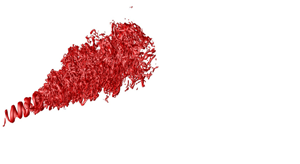Published online by Cambridge University Press: 18 September 2023

Direct numerical simulation of a compressible round jet is carried out at Mach number of 0.9 and Reynolds number of 3600 and the data are used to perform velocity gradient tensor (VGT) analysis for different regions of the spatially developing jet. For the developed portion of the jet, the classical teardrop shape is observed for the joint probability density function (p.d.f.) of Q and R (second and third invariants of the VGT). In the region just after the potential core, between  $X = 10$ and 15
$X = 10$ and 15  $r_0$ (
$r_0$ ( $r_0$ is the jet inlet radius), an inclination towards the third quadrant is observed in the Q–R joint p.d.f. which represents the presence of tube-like structures. It is also shown that this inclination in the turbulent/non-turbulent (T/NT) boundary and interface towards the third quadrant is mainly a contribution of points that lie in regions with negative dilatation. Regions with weak expansion also show this third quadrant inclination to some extent. Points that lie in regions with relatively higher positive dilatation show no such inclination towards the third quadrant but are inclined towards the fourth quadrant which indicates the presence of sheet-like structures. Similarly for the domain segment
$r_0$ is the jet inlet radius), an inclination towards the third quadrant is observed in the Q–R joint p.d.f. which represents the presence of tube-like structures. It is also shown that this inclination in the turbulent/non-turbulent (T/NT) boundary and interface towards the third quadrant is mainly a contribution of points that lie in regions with negative dilatation. Regions with weak expansion also show this third quadrant inclination to some extent. Points that lie in regions with relatively higher positive dilatation show no such inclination towards the third quadrant but are inclined towards the fourth quadrant which indicates the presence of sheet-like structures. Similarly for the domain segment  $X = 15$ to 20
$X = 15$ to 20  $r_0$, it is observed that points that lie in the regions with positive dilatation have a joint p.d.f. with an inclination towards fourth quadrant, which suggests the presence of sheet-like structures at the T/NT boundary and interface. Points that lie in regions with negative dilatation show the appearance of a third quadrant lobe.
$r_0$, it is observed that points that lie in the regions with positive dilatation have a joint p.d.f. with an inclination towards fourth quadrant, which suggests the presence of sheet-like structures at the T/NT boundary and interface. Points that lie in regions with negative dilatation show the appearance of a third quadrant lobe.